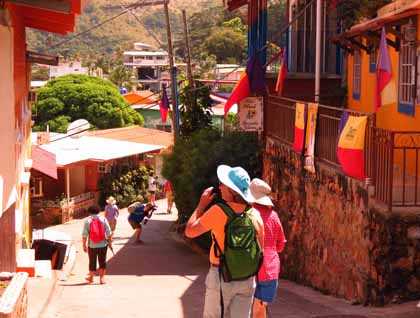After navigating over 190 nautical miles from the beautiful area of Coiba National Park, National Geographic Sea Lion was caught by the tropical sun in the very rich waters of the Bay of Panama. Compared to Costa Rican waters, these are richer in nutrients, which accounts for the increasing number of seabirds that our guests were able to see since the sunrise. The prevailing winds blow warm top water away so the nutrient-filled, cold bottom water reaches the surface, feeding a whole chain of animals.
Being outside on deck was a treat; the sun’s rays were strong but a pleasant cooling breeze coming from the east let us enjoy the view from this bay, which is naturally decorated by hundreds of islands, many of them not inhabited by humans but by outstanding numbers of brown boobies, brown pelicans and magnificent frigatebirds.
The morning outing was an extra bonus offered only when our Panamanian hotel manager Erasmo is on board. Taboga Island or “the flower island” has been his vacation home since childhood, so he kindly invited all 61 guests to walk through this little town and into his house for fresh-squeezed passion fruit drinks. The island is accessible by ferry from Panama City and is a well-known weekend destination for the locals. It was a pretty nice cultural visit, seeing the church, the narrow little roads, and the colorful houses. The famous painter Paul Gaugin made his home here for a while. After walking through this friendly town, we went back on board and off towards our Panama Canal appointment at Flamenco Signal.
The afternoon could not have been better. The hotel department prepared fresh ceviche and pico de gallo and brought it to us up on the sky deck, so we could enjoy the breathtaking sunset while crossing under the Bridge of the Americas, the entrance landmark of the Panama Canal.
So with our Panama Canal pilot on board, we started to make our way into the first set of locks, Miraflores and Pedro Miguel. We finally reached 85 feet above sea level in order to continue through the famous Culebra Cut, the narrowest part of the canal and the one that took a lot of human life.
It was late at night when we finished the crossing and dropped anchor in the Gatun Lake, closing the first part of our transit through one of the most spectacular feats of human engineering.






.jpg?width=106&height=85&mode=crop&scale=both&quality=50)


